Past events
Exhibition Report of 27th FINETECH JAPAN
Event outline

“27th FINETECH JAPAN” is the General Technology exhibition event that brings together the development and manufacturing technology on electronic display, organic electronics (organic EL, solid-state illumination, organic solar cells), and IoT equipment.
In this exhibition, we introduced our latest printing and ink technology by mainly focusing on High Definition Ink (High Quality and High Definition Screen Ink) we announced in July 2016.
- Period
- April 5 - 7,2017
- Venue
- Tokyo Big Sight
- Official HP
- http://www.ftj.jp/en/Home/
List of Exhibits
- 1. Introduction of ink applicable to sensor (IR Transmittable Ink)
- 2. Proposal of cost reduction by high resolution color separation
- 3. Introduction of Ink for glass providing high printing quality and excellent operation property
- 4. Solution of transmittance defect problem occurring at the time of printing transparent color
- 5. Solution for unevenness of printed ink layer in screen printing
- 6. Introduction of Clear with excellent sunscreen cream resistance
- 7. Introduction of “7 benefits” in High Definition Ink
1. Introduction of ink applicable to sensor (IR Transmittable Ink)
1.IR Transmittable Ink
IR Transmittable Ink is the ink transmitting infrared ray (IR) only and blocking other visible light or ultraviolet ray (e.g. sunlight). Since printed ink layer formed by printing this ink on transparent sheet blocks those other than infrared ray, it is used for light receiving section of remote controller and infrared reception part of mobile phones.
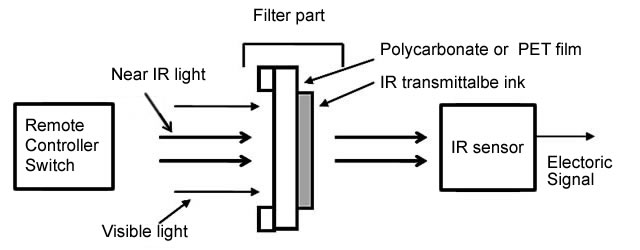
For example, using IR Transmittable Ink for IR receiving section of enables seamless design (with no borderline), as shown below.
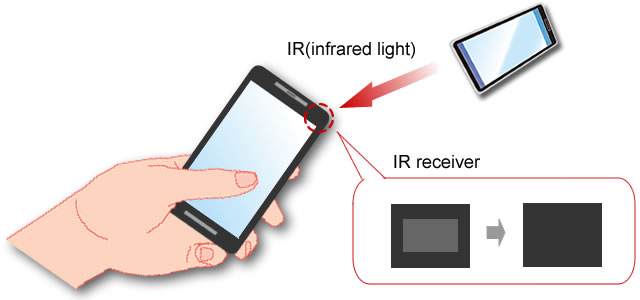
2.Ink for sensor applicable to various wavelength light other than IR (infrared ray)
IR Transmittable Ink is the ink applicable to sensor which can be used for receiving section of various sensors by adjusting wavelength light transmitted.
 Ink applicable to sensor (IR Transmittable Ink) Ink applicable to sensor (IR Transmittable Ink) |
Application: Remote controller, IR data transmission. |
 WHITE IR Transmittable Ink WHITE IR Transmittable Ink |
IR transmittance of white color which was hard to realize can be realized in combination with TORAY PICASUSR125-QP4A. |
 Ink for human detection sensor Ink for human detection sensor |
Application: Sensor people or obstacles in surroundings. IR transmitter and receiver are as 1 set. |
 Ink for eyespot authentication sensor Ink for eyespot authentication sensor |
Application: Illuminate specific lump to the face and sense light reflected from eyes. |
 Ink for camera sensor Ink for camera sensor |
Application: camera focusing. |
 Ink for environmental thermal sensor Ink for environmental thermal sensor |
Application: Sensor detecting heat in surroundings. |
 Ink applicable to sensor for environmental light-dark (ALS) Ink applicable to sensor for environmental light-dark (ALS) |
Application: Sensing environmental light-dark and adjust electricity in surroundings and screen light-dark. |
Application:
Smartphones, automobiles
Transmittance chart of each function
Controlling transmittance wavelength of ink enables realizing both sensor function and design property.
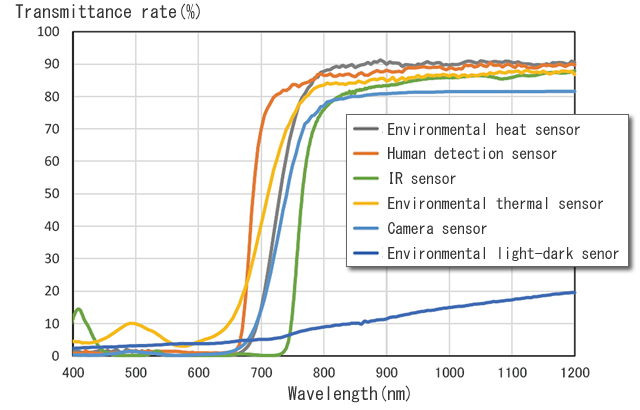
2. Proposal of cost reduction by high resolution color separation
1.Decreasing from 10 stencils – 10 processes to 5 stencils – 5 processes, which is significant reduction of stencil and operation cost
Normally, when illustration image and photo image are printed by screen printing, colors are multilayer printed tailored to the image hue. Therefore, more number of colors increase the number of stencil and printing process, and consequently increases cost.
However, High Resolution color separation ink can reproduce the image with the similarly high resolution in 4 colors and reduce the number of stencil and process, which enables printing illustration image and photo image with lower cost.
Application:
High Resolution image printing
Comparison of color separation printing process in conventional ink (upper photo) and High Resolution Ink (lower photo)
In conventional ink (upper photo), 10 stencils – 10 processes is required.
On the other hand, in High Definition Ink (lower photo), only half 5 stencils – 5 processes is required for finish.

3. Introduction of Ink for glass providing high printing quality and excellent operation property
1.Excellent characteristics of high dyne ink for glass
- Dyne value of printed ink layer is over 42, which realizes stable printed ink layer.
- Therefore, the ink is excellent in post-processing property for using bonding and double sided tape.
- It enables drying at lower temperature (120°C) compared to that of conventional ink for glass (150°C).
- It demonstrates excellent Solvent resistance to MEK, acetone, etc.
- It enables sharp printing on the edge face by adjusting fluidity and thixotropic property.
Application:
Decoration of window frame in smartphone, touch panels
Example of excellent printing edge face (outline printing of 1mm diameter circle in black solid pattern). Compared to conventional product
(left side photo), High dyne ink (right side photo) realizes beautiful printed boundary.

Ink type:
- DS-HF 60705 CS (Prototype)
4. Solution of transmittance defect problem occurring at the time of printing transparent color
1.Solution of transmittance defect problem by ink with high transparency which conventional product could not provide
The causes of transmittance defect occurring in Smoke print and IR transmittance printing are the following 4 factors.
1) Particle of pigment used
2) Leveling of printed ink layer
3) High thickness of printed ink layer
4) Change of ink viscosity
MIX-HF and TOC-HF inks with high transparency solves the above factors and realizes high-quality transmittance printing.
Transmittance rate and haze value of each ink are as follows.
| Ink name | Transmittance rate | Haze value |
| MIX-HF MEDIUM | 90.7% | 0.7% |
| TOC-HF MEDIUM | 89.4% | 0.6% |
Application:
Smartphone, touch panel, automotive meter
Material of indicator in car navigation system, etc.(Realization of both gray color printing and high transparency)

5. Solution for unevenness of printed ink layer in screen printing
1.High Definition Ink controlling physical change of ink which may cause unevenness and realizing high quality
At the time of printing Metallic and Pearl materials, ink viscosity change and ink dripping on stencil from squeegee may change density and orientation of Metallic and Pearl materials and cause unevenness in printed ink layer.
However, High Definition Ink maintains excellent physical property value even after containing metallic and pearl pigment material, which enables printing without unevenness.
Application:
Smartphones, touch panels, automotive meter
Example of printing Pearl Ink (looks black because of back light from back )
Unevenness was confirmed in conventional product (left side photo).Printed ink layer is even in High Definition Ink (right side photo).

6. Introduction of Clear with excellent sunscreen cream resistance
1.Excellent characteristics of JS-HF 70317 FT CLEAR (Prototype)
- Substrate: Polycarbonate, Acrylic
- The ink provides high resistance to chemicals such as sunscreen cream, lactic acid, etc.
- It enables 300% elongation in forming.
- 2 pack type Clear.
Pre-curing: Heat drying at 80℃ for 60 minutes
Forming: vacuum forming, Super-pneumatic forming
After-curing: Accumulated light energy: 250~300mJ/cm2, peak intensity: 3 50mW/cm2
Application:
Automotive interior
There is no sunscreen cream resistance, so printed ink layer becomes whitish.

There is no influence by Clear with sunscreen cream resistance.

7. Introduction of “7 benefits” in High Definition Ink
Benefit 1: Fine printability
The ink realizes beautiful expression and design with high resolution.Printing fine line of about 100µm hair with 100µm~116µm accuracy.
In conventional ink (left side photo), bleed occurs due to 50µm width fine line.In High Definition Ink (right side photo), 50µm width fine line can also be printed.
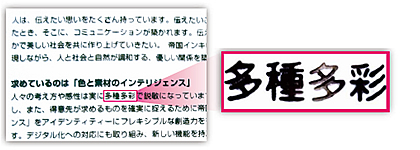
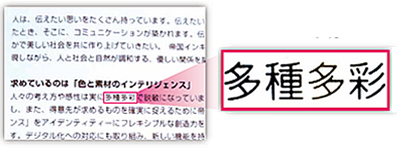
Benefit 2: Simultaneous printing of solid pattern and fine line
High Definition Ink enables simultaneous printing of solid pattern, thin line, and gradation, which enables significant cost reduction by reducing the number of stencil and man-hour.
Example of simultaneous printing of Solid – Thin Line (30µm) – Solid – Gradation

Benefit 3: Countermeasure for saw edge
Saw edge below 10µm realizes beautiful straight line and true circle without concavo-convex.
The following photo is an example of outline printing of smartphone window frame (circle with 1mm diameter).
Concavo-convex occurs in printed boundary of conventional product (left side photo).On the other hand, beautiful printed boundary was realized in High Definition Ink (right side photo).

Benefit 4: Continuous printability
High Definition Ink realizes both productivity improvement and reduction of defective rate. It enables continuous printing of 1500 sheets with 100µm~116µm of fine printing.
In conventional Ink (left side photo), ink spatter occurred in printing 300th sheets. In High Definition Ink (right side photo), stable finish is possible even after 1500 sheets of continuous printing.
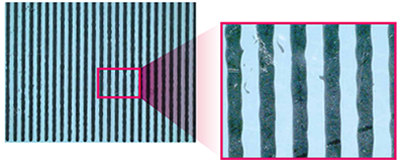
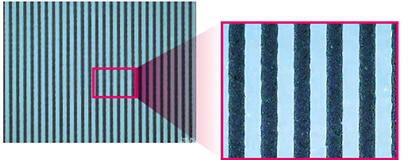
Benefit 5: High-speed Printability
High Definition Ink enables high-speed printing of 800~1500 sheets/hour by cylinder press even in 100µm~116µm of fine printing.

Benefit 6: Re-printability
It enables reprinting even after covering ink on stencil and leaving for 1 hour. Operation property significantly improves such as reduction of time waste while interruption of printing operation.
Leaving conventional ink (left side photo) for 30 minutes on stencil. Leaving High Definition Ink (right side photo) for 60 minutes on stencil.
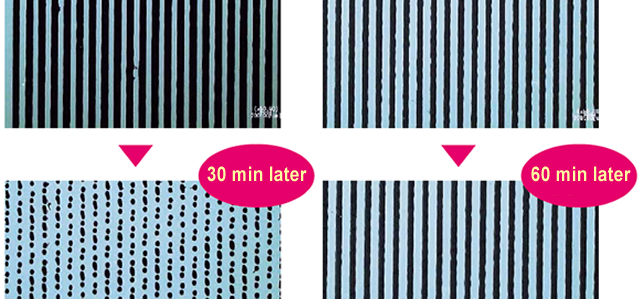
Benefit 7: Reduction of the number of cleaning stencil
High Definition Ink enables reduction of the number of cleaning stencil up to one fifth of that of conventional ink.
Stable printingreduces the number of cleaning stencil to one fifth!
- Related technical information
-
- Introduction of IRX-HF ink
- Introduction of GLS-HF ink(2)
- Introduction of IR transmittable ink (IR Transmitting Ink) and concealed printing
- Introduction of 7 benefits
- Introduction of High Quality and High Definition Screen Printing Ink
- Introduction of High-Definition Ink (high-quality, high-definition screen ink)
- Introduction of MIX-HF ink(3)
- Introduction of MIX-HF(1)
- Introduction of transparent ink TOC-HF(1)
Please feel free to contact us about the inks, methods, and trial products we have introduced.

